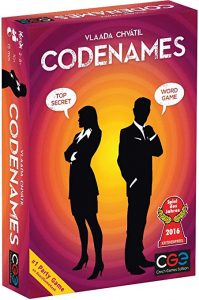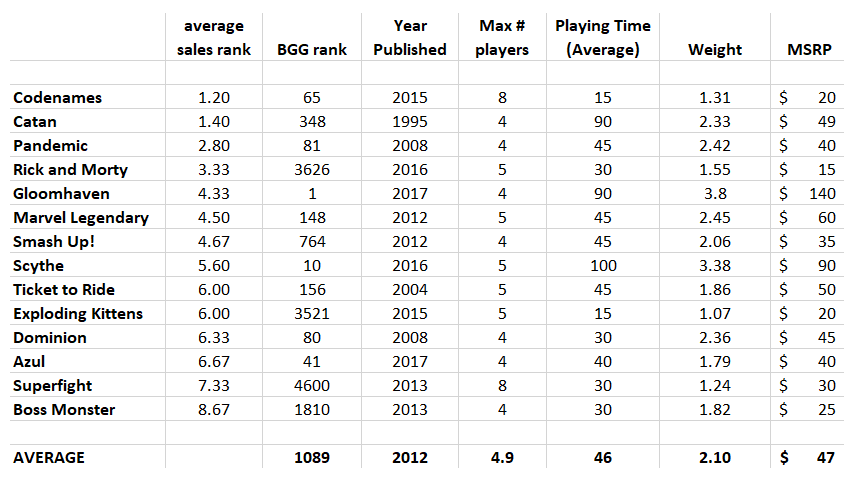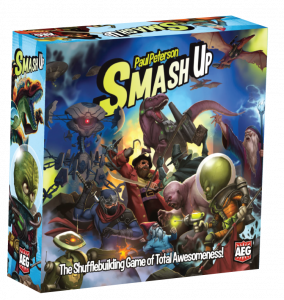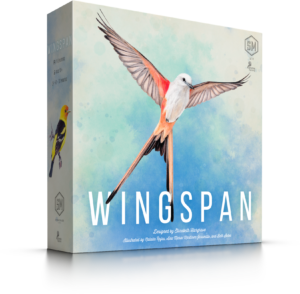 Five years ago, I compiled data from several sources for an article called How to Design and Publish an Evergreen Board Game. As we near the end of 2019, I thought it might be a good time to revisit the concept of games that continually sell well, year after year.
Five years ago, I compiled data from several sources for an article called How to Design and Publish an Evergreen Board Game. As we near the end of 2019, I thought it might be a good time to revisit the concept of games that continually sell well, year after year.
Please note before proceeding that the title of this post is a bit of a misnomer. There is no actual magic formula; rather, there are patterns, data, and averages to consider. You have control over some (but not all) of these factors, and there are several exceptions and outliers.
To compile this list, I looked at the last 5 of ICv2’s bi-annual articles containing the top 10 bestselling hobby channel board games, card games, and dice games (like this one). As ICv2 notes, “The charts are based on interviews with retailers, distributors, and manufacturers.” To qualify for this list, a game must have appeared at least 3 times on these lists, which span from spring 2017 to spring 2019 (the fall list won’t post for another couple of months).
Here are the 14 games that qualified for the list:

Results
Here’s my interpretation of the results, including considerations for publishers (including Stonemaier Games):
- BoardGameGeek ranking (1089): I think it’s fair to say that having a well-rated game doesn’t hurt. But there is a vast world of game buyers and players beyond those who participate on BGG. Pick a target audience and make your game as fun as possible for that audience.
- Year Published (2012): I think the lesson here is “be patient.” Yes, it’s great to have a hit out of the gate, whether it’s on Kickstarter or released first to retailers. But bestselling evergreen games are all about the long tail, not short-term gains. Strategically budget and plan to reprint (and support with expansions) your game over many years…though I always try to stay nimble, as some games just aren’t going to hit the sweet spot you were hoping for.
- Max # of Players (5): Keep in mind that I only used data from core games, not expansions (as it’s the bestselling nature of the core game I’m examining here). While there are some extremely successful games on this list that only play up to 4 players, it seems that games that play up to 5 are appealing to a wide audience.
 Playing Time (45 minutes): A caveat is that this is the playing time according to publishers, so let’s add 15 minutes to it across the board (more if you include setup and cleanup). It appears to me that most bestselling games play in (or just under) an hour. On my playtesting surveys, I always ask about playing time (including setup and cleanup).
Playing Time (45 minutes): A caveat is that this is the playing time according to publishers, so let’s add 15 minutes to it across the board (more if you include setup and cleanup). It appears to me that most bestselling games play in (or just under) an hour. On my playtesting surveys, I always ask about playing time (including setup and cleanup).- Weight (2.10): This is a user-reported number on BoardGameGeek that determines how heavy/complex games are on a 5-point scale. Examples of games near the 2.10 average are Smash Up, Dominon, and Catan; I’d classify these as “medium-light games”. They’re games with fairly simple rules but plenty of interesting decisions that emerge throughout the game.
- MSRP ($47): While Gloomhaven and Scythe skew this data a bit, it sounds like games in the $40-$60 range definitely have the potential to become bestselling evergreens. Yes, a simple cards-only game can do well, but the $47 average is encouraging to me, as that gives publishers the flexibility to feature some beautiful, satisfyingly tactile components in their games.
What doesn’t the data show?
- Only 2 of these games have a major intellectual property associated with them (though many of these games have IP spinoffs–it’s possible they’re included in ICv2’s data).
- The majority (9) of these games are competitive, and 5 of them are cooperative or team-based.
- Most of these games offer a fluid style of play–players continuously take turns until the end-game is triggered instead of breaking the game into rounds (and sometimes a set number of rounds).
- There are no 2-player only games on this list, though almost all of these games play well with only 2 players.
- There’s only 2 games on this list that feature miniatures, and neither Scythe nor Gloomhaven are what people would call “miniatures games.” ICv2 does have a separate list for non-collectible miniatures games, but even those games are distinctly different than the typical miniature-heavy games that do so well on Kickstarter. Perhaps those games are just too expensive to have a long tail.
- Only 4 of these games originated from Kickstarter campaigns.
 Future predictions
Future predictions
A few games started to creep onto this list but haven’t been around for long enough to meet the minimum of 3 appearances on ICv2’s lists to qualify. Among them, I think we’ll see Root, Sagrada, and The Mind show up on future lists. Other games that I think have the potential to make this list are Wingspan, Quacks of Quedlinburg, Welcome To, Just One, 7 Wonders, and Parks.
Stonemaier Games
We only publish 2 new games each year at most, so my goal is that each of those games has the potential to become an evergreen bestseller. That isn’t why I make games, but it’s still one of my targets I aim for. Most of our games are close to the averages mentioned here, though several of them tend to run longer and be a little heavier. The price point is something I want to continue to be aware of, as it’s my instinct to deluxify the core versions of our games, but that often pushes the MSRP up beyond the $40-$60 sweet spot that I try to target.
***
What do you see in this data that I’m missing? I’d love to hear your thoughts.
Also read: 5 Revelations from Our 2019 Demographic Survey
If you gain value from the 100 articles Jamey publishes on his blog each year, please consider championing this content!
29 Comments on “The Magic Formula for Publishing an Evergreen Tabletop Game”
Leave a Comment
If you ask a question about a specific card or ability, please type the exact text in your comment to help facilitate a speedy and precise answer.
Your comment may take a few minutes to publish. Antagonistic, rude, or degrading comments will be removed. Thank you.


[…] posed this question in 2014 and in 2019, and I thought it was time to revisit the topic. To compile the following list, I looked at […]
Jamey,
As a mathematician I cringe that you compute averages to draw conclusions. Even you pointed out that it is highly affected by outliers (Gloomhaven alone increased the average MRSP by 10 points). I strongly encourage you to use Medians instead (https://en.wikipedia.org/wiki/Median).
Just as an example, median price of the listed games is 40$ (whereas average is 47). Now, you look at BGG rank and average is over 1k….instead, the median is 152!
Median can be easily calculated with any spreadsheet program. Let me know if you need help with that
Did the list specifically exclude CAH, or is it really not in the top 14? Based on what I hear from distributors and retailers that would suprise me greatly.
It made it onto the list twice, and I’m sure they outsell many other games, but unless something changed, they haven’t traditional sold to distributors/retailers.
If you order the games by year then weight, there’s an interesting trend and correlation with price point.
1995 2.33
2004 1.86
2008 2.36
2008 2.42
2012 2.06
2012 2.45
2013 1.24
2013 1.82
2015 1.07
2015 1.31
2016 1.55
2016 3.38
2017 1.79
2017 3.8
No game with a greater weight than 2.45 appeared on this list until 2016. Then you had Scythe at 3.38, MSRP $90, followed by Gloomhaven in 2017, weight 3.8, MSRP $140. The average MSRP of the other 12 is only $35.75, not $47, when you factor out the two “premium” games. The median of the 12 lighter weighted games is $37.5.
Interesting, no?
That is definitely interesting!
In poking at the data on the player count it makes me wonder whether that is correlated to having more people to be able to talk and spread the word about a game. Since more people can consume a 4+ player game vs a 1-3 during each play you have more social networks to utilize to spread awareness via essentially free marketing. Thanks for putting this together. As PhD Candidate I love the data behind things and then getting to ask questions for research. :)
I like that theory! I really believe in the multiplicative aspect of gaming.
I think these games actually have almost nothing in common, with one exception: they are all different from each other. Just as Clue, Monopoly, Candyland, Scrabble, Sorry, and Trivial Pursuit all do something fundamentally different from one another, so too these games would seem to suggest that there’s only “room at the top” for one of each type of game. But what they also show is that there probably isn’t a fixed number of “types” of game that can exist, so a new game that does something singular can rise to be a hit, but a game that’s similar to what already exists will have to unseat something else, a pretty tall order given this list.
One factor could be how easy to teach a game is. It’s more likely I bring a game to the table or introduce people to it when I don’t have to rehearse my teaching. Azul, Codenames, Quacks of Quedlinburg and Wingspan were a big hit with my non-gamer friends and colleagues (Codenames and Just One are also great team-building games).
A light to medium boardgamegeek rating may imply that a game is easy to teach but as a matter of fact not all of them are. This also correlates with the playing-time – the sooner you can start playing the sooner the fun part begins.
For me personally a great solo-variant is a factor as well as it makes me go back to a game during times when it’s not popular in my gaming group (luckily evergreens will eventually make a comeback).
I agree, teachability (and ease of getting to the table) makes a huge difference in how much a game will spread.
I was considering this when I was reading the predictions in the last paragraph. Most of them I agree with, but Root seemed like an anomoly for me. Given how deeply Cole Wehrle committed to the asynch style, the entry bar for Root seems pretty high for the average gamer, let alone the casual non-gamer. I could be wrong, though.
Which Rick and Morty Game is on that list, there are a lot of Rick and Morty based titles. I am amazed that a game like Scythe can compete with a game like Ticket to Ride. I had always assumed that lighter games like TTR would reach a much wider audience than heavier games like Scythe. Congrats on your continued success!!
I would much rather see total units sold and not total sales. I would also like to see data from the Mass Channel. The hobby channel aggregated based on sales alone holds a bit of bias. And curious if there are any limitations to the data. If certain distributors did not report, if the data is strictly from the distributor level or if it’s actual units sales at POS. If it’s only brick and mortar sales or if it includes online retailers. There is a lot more that goes into being qualified an evergreen than temporarily cracking the top sales list of the hobby channel.
Richard: As noted in the post, The charts are based on interviews with retailers, distributors, and manufacturers. To qualify for this list, a game must have appeared at least 3 times on these lists, which span from spring 2017 to spring 2019 (the fall list won’t post for another couple of months), so it’s more than just temporarily cracking the list.
Of course, more data is almost always helpful.
Wow, that kind of data is available? That is very impressive.
I wonder if the gateway nature of a lot of these games has anything to do with it. It’s noted above that the median weight of these games is only 1.96, since Scythe and Gloomhaven push up the mean of the other, lighter games.
A lot of these strike me as gateway games, where you’re going to be getting a good crossover of both more casual players and more serious collectors. The big one though, is that most of these are carried by national retailers (Target, Walmart, etc), which is where the accessibility also comes into play.
I’d be curious to see what’s on this list in five years as the hobby becomes more accessible and gains more mainstream popularity.
As always, a thought provoking summary Jamey.
When you commented on the play time and weight. I immediately thought of the Spiel des Jahres. Catan, Dominion, Codenames, Ticket to Ride, Azul were all winners, and Pandemic was a finalist. Given the focus of ICv2 on North America, that comes as a bit of a surprise.
Would you say North Americans look for Spiel des Jahres winners, or is this more a case of the SdJ understanding the larger gaming audience?
norkle: That’s a great observation. My guess would be that SdJ games are just really good games that a lot of people want to buy and play.
And I forgot to mention Wingspan being a SdJ winner. That’s an amazing achievement, and testament to paying attention to the gaming audience.
Looking forward a future analysis of the benefit of a SdJ award :-)
It would be fascinating to plot the sales numbers against the award winning and nominated data for more than just the SdJ as well. Sometimes those other seals of approval (see also Dice Tower) get printed on the box. There’s a virtuous cycle where winning a prestigious prize is good marketing, so people complete hard for it, so it gains more worth and prestige.
I’m also curious if regardless of sales, you get a solid correlation out of awards when you compare them to ratings and recommendations. For instance, can you find the best awards that solidly predict the rating, or jibe with a certain kind of gamer, just using the BGG data set? My instinct is you can.
The difference in a few categories is fairly small, but looking at medians versus averages may be helpful here, especially on the price side of things. Whereas the average price is all of the prices added together and divided by the number of entries, the median is the price that has half the prices above it and half below it. The average price is $47 while the median price is $40 – that eliminates some of the skew coming from the big price tags of Scythe and Gloomhaven. While very subjective, moving the number of $47 to $40 could imply a pull away from the pricing associated with lots of “hobby” games and closer to that someone would perhaps impulse or gift buy at a big box store.
Does channel impact these numbers at all? Are all of these carried at big box stores?
You see some changes if you look at the median for BGG rank – where the average is 1089, the median is 152, which puts half of these games among the highest rated games on BGG.
Median also pulls down the difficult a hair, too, coming it at 1.96 as opposed to 2.10.
I’m also surprised to not see something like Munchkin on this list.
That’s a good point about medians, Jonathan. I think almost all of these are carried at hobby game stores and online stores, though Superfight might only be available direct.
I’m sure Munchkin sells well (and other lasting games like Love Letter and 7 Wonders)–they would probably be here if ICv2’s list was a top 20 list instead of top 10.
“What do you see in this data that I’m missing?”
Of the 5 outliers that break the weight average, 4 are very good when played solo.
Morten will be happy.
P.S. Pandemic is also a great solo game.
Solo play! I’m glad you mentioned that. :)
interesting
Hi,
Which of the games listed have IP’s?
And has this protected them?
Rick and Morty and Marvel Legendary have IPs (they’re in the name :) ). Protected them from what?
While Exploding Kittens doesn’t have IP, per se, Matthew Inman’s The Oatmeal brought a known art style and tone to it creating an instant audience. Joking Hazard may become similarly popular for that same reason. I expect other to pop up in this vein and be moderately successful over the long haul.